Abstract
Specific humoral substances produced and secreted by human tumors that cause hypercalcemia have not been identified. Certain growth factors (such as epidermal growth factor, platelet-derived growth factor, and transforming growth factors-alpha and -beta) have been shown to stimulate the resorption of bone in organ culture by both prostaglandin-dependent and prostaglandin-independent pathways. In this report we demonstrate that epidermal growth factor and recombinant human transforming growth factor-alpha induce a significant rise in plasma calcium concentration when administered repeatedly to intact mice for periods ranging from 24 h to 16 d. The elevation of plasma calcium is not dependent on dietary calcium and is not invariably accompanied by an increase in systemic levels of the prostaglandin E2 metabolite 13,14-dihydro-15-keto-prostaglandin E2. The in vivo calcium-mobilizing activity of epidermal growth factor and transforming growth factor-alpha indicate that these or related growth factors need be considered as potential mediators of tumor-induced hypercalcemia.
Full text
PDF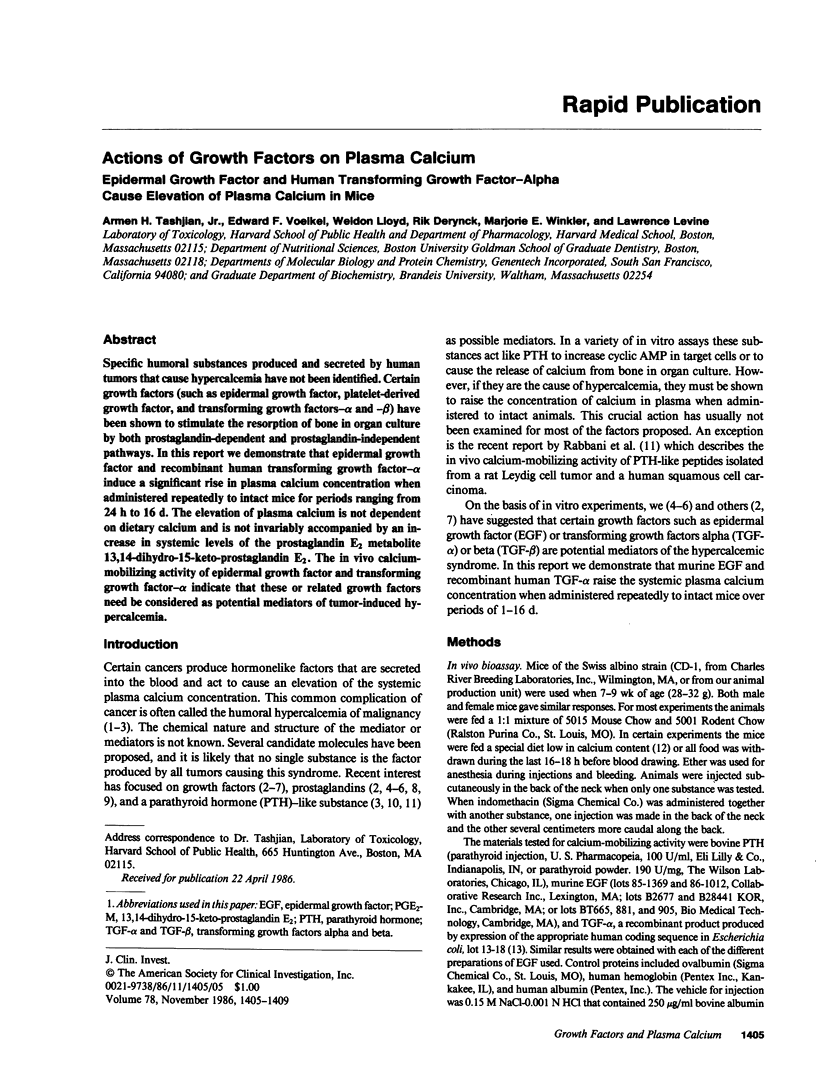
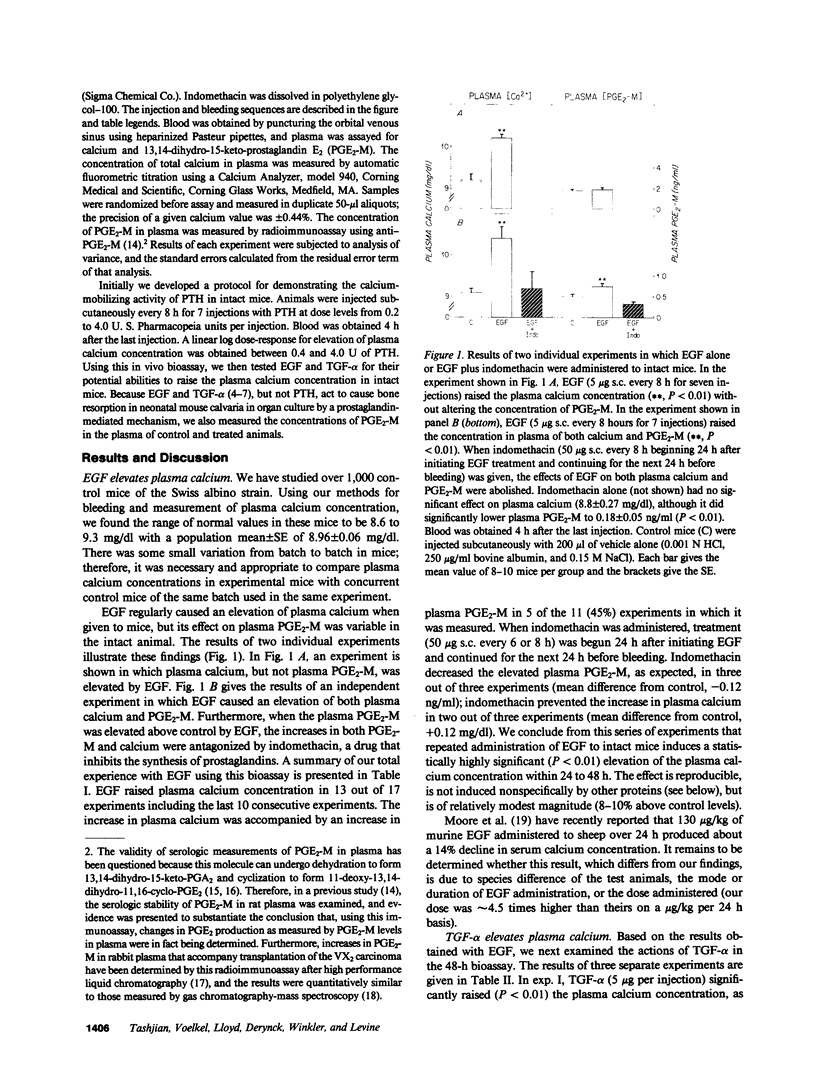
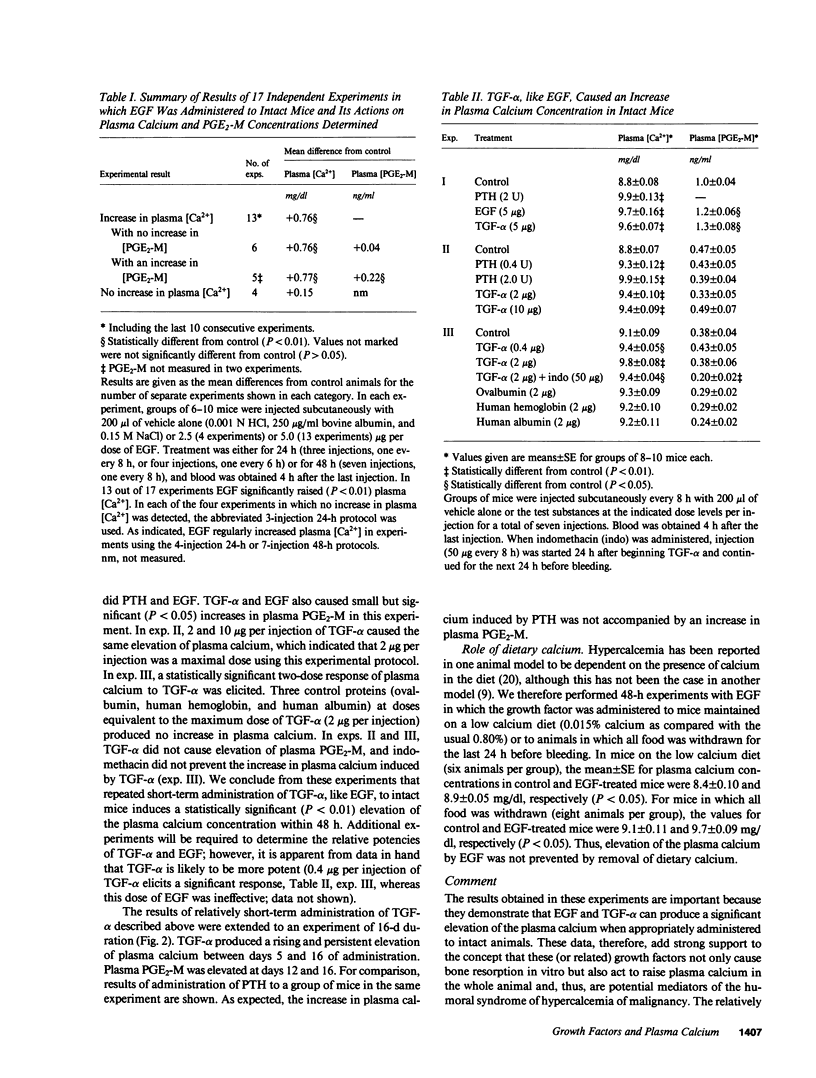
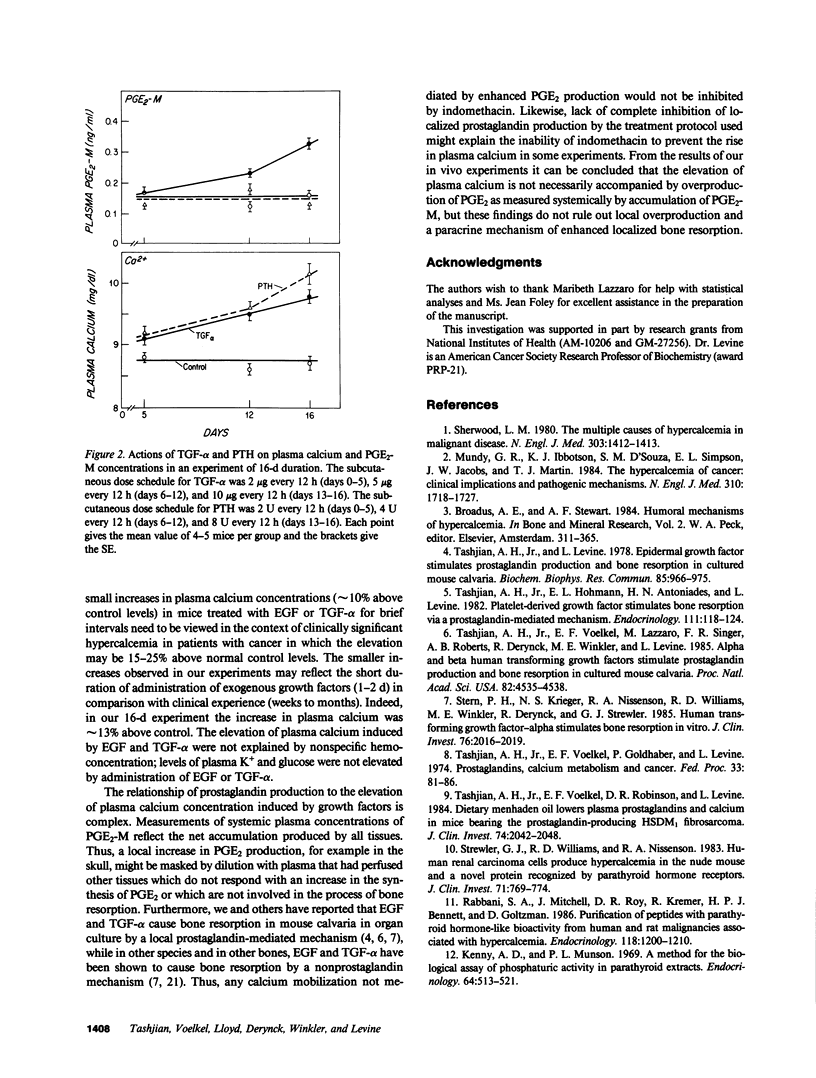
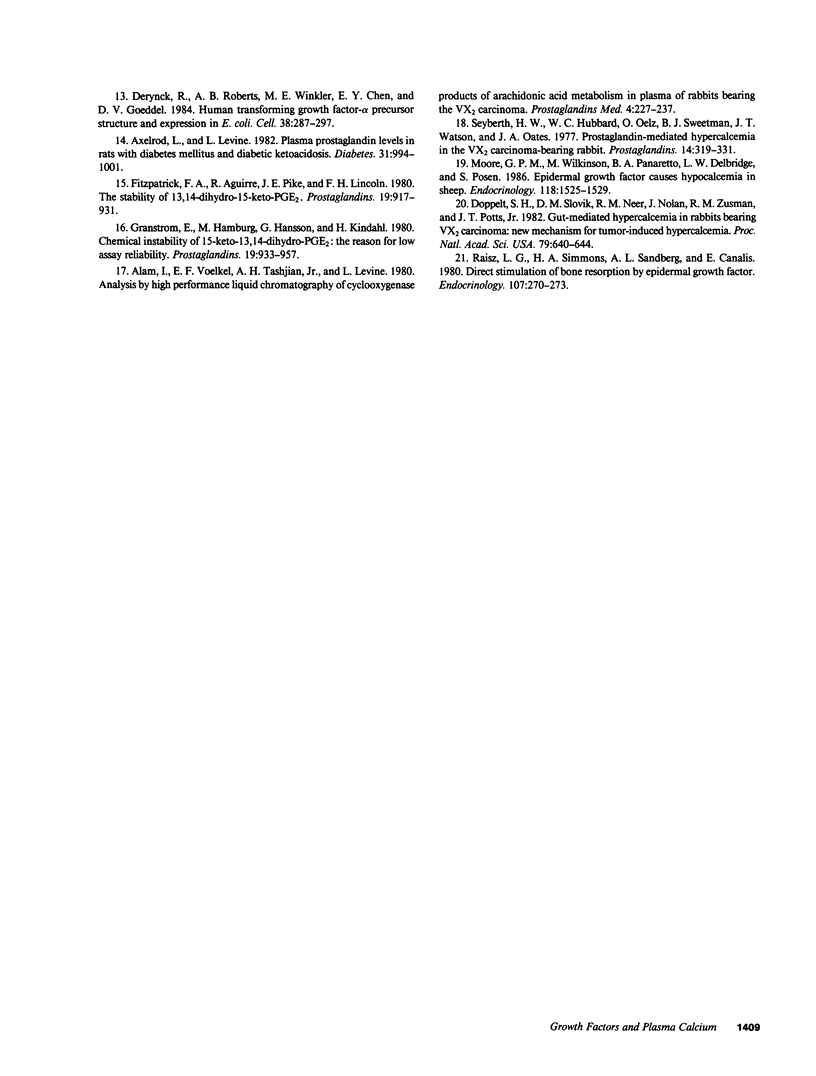
Images in this article
Selected References
These references are in PubMed. This may not be the complete list of references from this article.
- Alam I., Voelkel E. F., Tashjian A. H., Jr, Levine L. Analysis by high performance liquid chromatography of cyclooxygenase products of arachidonic acid metabolism in plasma of rabbits bearing the VX2 carcinoma. Prostaglandins Med. 1980 Apr;4(4):227–237. doi: 10.1016/0161-4630(80)90017-8. [DOI] [PubMed] [Google Scholar]
- Axelrod L., Levine L. Plasma prostaglandin levels in rats with diabetes mellitus and diabetic ketoacidosis. Diabetes. 1982 Nov;31(11):994–1001. doi: 10.2337/diacare.31.11.994. [DOI] [PubMed] [Google Scholar]
- Derynck R., Roberts A. B., Winkler M. E., Chen E. Y., Goeddel D. V. Human transforming growth factor-alpha: precursor structure and expression in E. coli. Cell. 1984 Aug;38(1):287–297. doi: 10.1016/0092-8674(84)90550-6. [DOI] [PubMed] [Google Scholar]
- Doppelt S. H., Slovik D. M., Neer R. M., Nolan J., Zusman R. M., Potts J. T., Jr Gut-mediated hypercalcemia in rabbits bearing VX2 carcinoma: new mechanism for tumor-induced hypercalcemia. Proc Natl Acad Sci U S A. 1982 Jan;79(2):640–644. doi: 10.1073/pnas.79.2.640. [DOI] [PMC free article] [PubMed] [Google Scholar]
- Fitzpatrick F. A., Aguirre R., Pike J. E., Lincoln F. H. The stability of 13,14-dihydro-15 keto-PGE2. Prostaglandins. 1980 Jun;19(6):917–931. doi: 10.1016/0090-6980(80)90126-4. [DOI] [PubMed] [Google Scholar]
- Granström E., Hamberg M., Hansson G., Kindahl H. Chemical instability of 15-keto-13,14-dihydro-PGE2: the reason for low assay reliability. Prostaglandins. 1980 Jun;19(6):933–957. doi: 10.1016/0090-6980(80)90127-6. [DOI] [PubMed] [Google Scholar]
- KENNY A. D., MUNSON P. L. A method for the biological assay of phosphaturic activity in parathyroid extracts. Endocrinology. 1959 Apr;64(4):513–521. doi: 10.1210/endo-64-4-513. [DOI] [PubMed] [Google Scholar]
- Moore G. P., Wilkinson M., Panaretto B. A., Delbridge L. W., Posen S. Epidermal growth factor causes hypocalcemia in sheep. Endocrinology. 1986 Apr;118(4):1525–1529. doi: 10.1210/endo-118-4-1525. [DOI] [PubMed] [Google Scholar]
- Mundy G. R., Ibbotson K. J., D'Souza S. M., Simpson E. L., Jacobs J. W., Martin T. J. The hypercalcemia of cancer. Clinical implications and pathogenic mechanisms. N Engl J Med. 1984 Jun 28;310(26):1718–1727. doi: 10.1056/NEJM198406283102607. [DOI] [PubMed] [Google Scholar]
- Rabbani S. A., Mitchell J., Roy D. R., Kremer R., Bennett H. P., Goltzman D. Purification of peptides with parathyroid hormone-like bioactivity from human and rat malignancies associated with hypercalcemia. Endocrinology. 1986 Mar;118(3):1200–1210. doi: 10.1210/endo-118-3-1200. [DOI] [PubMed] [Google Scholar]
- Raisz L. G., Simmons H. A., Sandberg A. L., Canalis E. Direct stimulation of bone resorption by epidermal growth factor. Endocrinology. 1980 Jul;107(1):270–273. doi: 10.1210/endo-107-1-270. [DOI] [PubMed] [Google Scholar]
- Seyberth H. W., Hubbard W. C., Oelz O., Sweetman B. J., Watson J. T., Oates J. A. Prostaglandin-mediated hypercalcemia in the VX2 carcinoma-bearing rabbit. Prostaglandins. 1977 Aug;14(2):319–331. doi: 10.1016/0090-6980(77)90177-0. [DOI] [PubMed] [Google Scholar]
- Sherwood L. M. The multiple causes of hypercalcemia in malignant disease. N Engl J Med. 1980 Dec 11;303(24):1412–1413. doi: 10.1056/NEJM198012113032409. [DOI] [PubMed] [Google Scholar]
- Stern P. H., Krieger N. S., Nissenson R. A., Williams R. D., Winkler M. E., Derynck R., Strewler G. J. Human transforming growth factor-alpha stimulates bone resorption in vitro. J Clin Invest. 1985 Nov;76(5):2016–2019. doi: 10.1172/JCI112202. [DOI] [PMC free article] [PubMed] [Google Scholar]
- Strewler G. J., Williams R. D., Nissenson R. A. Human renal carcinoma cells produce hypercalcemia in the nude mouse and a novel protein recognized by parathyroid hormone receptors. J Clin Invest. 1983 Mar;71(3):769–774. doi: 10.1172/JCI110825. [DOI] [PMC free article] [PubMed] [Google Scholar]
- Tashjian A. H., Jr, Hohmann E. L., Antoniades H. N., Levine L. Platelet-derived growth factor stimulates bone resorption via a prostaglandin-mediated mechanism. Endocrinology. 1982 Jul;111(1):118–124. doi: 10.1210/endo-111-1-118. [DOI] [PubMed] [Google Scholar]
- Tashjian A. H., Jr, Levine L. Epidermal growth factor stimulates prostaglandin production and bone resorption in cultured mouse calvaria. Biochem Biophys Res Commun. 1978 Dec 14;85(3):966–975. doi: 10.1016/0006-291x(78)90638-1. [DOI] [PubMed] [Google Scholar]
- Tashjian A. H., Jr, Voelkel E. F., Goldhaber P., Levine L. Prostaglandins, calcium metabolism and cancer. Fed Proc. 1974 Jan;33(1):81–86. [PubMed] [Google Scholar]
- Tashjian A. H., Jr, Voelkel E. F., Lazzaro M., Singer F. R., Roberts A. B., Derynck R., Winkler M. E., Levine L. Alpha and beta human transforming growth factors stimulate prostaglandin production and bone resorption in cultured mouse calvaria. Proc Natl Acad Sci U S A. 1985 Jul;82(13):4535–4538. doi: 10.1073/pnas.82.13.4535. [DOI] [PMC free article] [PubMed] [Google Scholar]
- Tashjian A. H., Jr, Voelkel E. F., Robinson D. R., Levine L. Dietary menhaden oil lowers plasma prostaglandins and calcium in mice bearing the prostaglandin-producing HSDM1 fibrosarcoma. J Clin Invest. 1984 Dec;74(6):2042–2048. doi: 10.1172/JCI111627. [DOI] [PMC free article] [PubMed] [Google Scholar]



